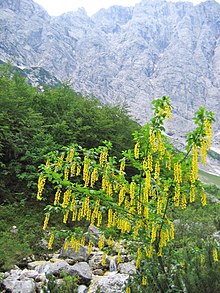Laburnum (plant)
| Laburnum | ||||||||||||
|---|---|---|---|---|---|---|---|---|---|---|---|---|

Common laburnum ( Laburnum anagyroides ) |
||||||||||||
| Systematics | ||||||||||||
|
||||||||||||
| Scientific name | ||||||||||||
| Laburnum | ||||||||||||
| Fabr. |
Laburnum ( Laburnum ), also bean tree , gold rush or Yellow Bush called, is a genus of the subfamily of the Pea family (Faboideae) in the family of legumes (Fabaceae).
The Common Laburnum ( Laburnum anagyroides ), also Common laburnum called, is due to its yellow blooms a very popular ornamental shrub. It was voted poisonous plant of the year in 2012. The Indian laburnum other hand, belongs to the kind of Kassien ( Cassia ).
description

Vegetative characteristics
Laburnum species are shrubs or small trees that reach a height of 5 to 6 meters. They have thornless branches.
The alternate leaves are long-stalked and pinnate in three parts. They are narrow-egg-shaped to narrow-elliptical, 3–8 cm long, pointed or blunt at the end and narrowed or rounded at the base in a wedge shape. The stipules are small.
Generative characteristics
The lateral or pseudo-terminal, drooping, long, simple, racemose inflorescences contain bracts, tiny bracts and many flowers.
The zygomorphic flowers are hermaphroditic and five-fold. The calyx is slightly two-lipped. They are typical butterfly flowers . With the five yellow petals , the boat is smaller than the wings and the flag is oval to circular. The ovary contains many ovules . The smooth stylus ends in a scar.
The first green, when ripe, dark green to brown and bean-like legume contains many seeds and is slightly constricted between the seeds. The dark brown to black seeds are flat.
use
The laburnum varieties make little demands on the climate and soil. They bloom profusely from April to June and are often found as ornamental trees in parks and gardens .
Toxicity
Both types of golden rain contain the poison cytisine . The alpine laburnum also contains the poison Ammodendrin , especially in the leaves .
Systematics
The genus Laburnum was established in 1759 by Philipp Conrad Fabricius in Enumeratio Methodica Plantarum , p. 228. A homonym is Laburnum Medik. published in Vorles. Churpfälz. Phys.-Öcon. Ges. , 2, 1787, 362.
The genus Laburnum belongs to the tribe Genisteae in the subfamily of the butterflies (Faboideae) within the family of the legumes (Fabaceae).
The genus Laburnum contains only two species:
- Alpine laburnum ( Laburnum alpinum (Mill.) Bercht. & J.Presl , Syn .: Cytisus alpinus Mill. ): It is native to Europe. An extract obtained from it was used in criminology to detect blood group 0 .
- Common laburnum ( Laburnum anagyroides Medik. , Syn .: Cytisus laburnum L. , Laburnum vulgare J. Presl )
There is also a hybrid of these two species:
- Hybrid laburnum ( Laburnum × watereri (Wettst.) Dippel )
swell
- Syed Irtifaq Ali: Papilionaceae. : Laburnum at Tropicos.org. In: Flora of Pakistan . Missouri Botanical Garden, St. Louis
Individual evidence
- ↑ Andreas Kelich: Cytisine. Retrieved July 31, 2010 .
- ↑ laburnum at naturlexikon.com. Retrieved June 26, 2014 .
- ^ Laburnum at Tropicos.org. Missouri Botanical Garden, St. Louis, accessed November 18, 2015.
- ↑ Data sheet at International Legume Database Information Service = ILDIS - LegumeWeb - World Database of Legumes , Version 10.38 from July 20, 2010.
- ↑ Jürgen Thorwald : The hour of the detectives. Becomes and worlds of criminology. Droemer Knaur, Zurich and Munich 1966, p. 208 f.

